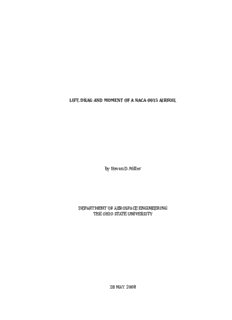
LIFT, DRAG AND MOMENT OF A NACA 0015 AIRFOIL PDF
Preview LIFT, DRAG AND MOMENT OF A NACA 0015 AIRFOIL
LIFT, DRAG AND MOMENT OF A NACA 0015 AIRFOIL by Steven D. Miller DEPARTMENT OF AEROSPACE ENGINEERING THE OHIO STATE UNIVERSITY 28 MAY 2008 i ABSTRACT A NACA 0015 symmetrical airfoil with a 15% thickness to chord ratio was analyzed to determine the lift, drag and moment coefficients. A 2D airfoil was placed in a low speed wind tunnel with pressure taps along its surface and a pitot probe downstream to measure the flow characteristics. The wind tunnel was operated at a nominal 17 m/s during the coefficient measurements, a Reynold's number of about 232,940. The airfoil, with an 8 in chord, was analyzed at 0, 5, 10 and 15 degree angles of attack. The phenomenon known as hysteresis with regards to stall conditions was also observed by varying the angle of attack and wind tunnel velocity. ii TABLE OF CONTENTS Page List of Figures iv List of Tables iv Nomenclature v Chapter I. Introduction 1 II. Apparatus and Instrumentation 2 III.Experimental Procedure 4 IV. Analysis 5 V. Results and Discussion 7 VI.Conclusions 13 Appendix 14 References 18 iii LIST OF FIGURES Figure Page 1 NACA 0015 Airfoil Cross-section with Pressure Taps 2 2 Pressure Distribution at 0 Deg Angle of Attack 8 3 Pressure Distribution at 5 Deg Angle of Attack 9 4 Pressure Distribution at 10 Deg Angle of Attack 9 5 Pressure Distribution at 15 Deg Angle of Attack 10 6 Velocity Profile of the Downstream Wake 11 LIST OF TABLES Tables Page 1 Lift, Drag and Moment Coefficients 12 iv NOMENCLATURE c Chord f Function u Velocity C Coefficient of Drag D C Coefficient of Friction f C Coefficient of Lift L C Moment Coefficient M C Coefficient of Pressure p D Drag I Integral R Reynold's Number e u Free Stream Velocity α Angle of Attack ρ Density v INTRODUCTION This experiment analyzes the NACA 0015 airfoil in a low speed wind tunnel at varying angles of attack. The NACA 0015 is a symmetrical airfoil with a 15% thickness to chord ratio. Symmetric airfoils are used in many applications including aircraft vertical stabilizers, submarine fins, rotary and some fixed wings. A 2D wing section is analyzed at low speeds for lift, drag and moment characteristics. A second goal of the experiment was to observe the hysteresis effect of the stall speed and angle of attack. This is important to understanding the stall characteristics of this airfoil. 1 APPARATUS AND INSTRUMENTATION The experiment was conducted in the Aerospace Engineering's subsonic wind tunnel located at The Ohio State University main campus. This is a low turbulence, closed-loop atmospheric wind tunnel capable of tunnel velocities of 40 m/s1 and is descibed in detail in reference 2. A NACA 0015 airfoil, made of composite materials and mounted in the center of the test section was used for this experiment. The airfoil has a 8 in chord, extended the full width of the tunnel and had several small streamers taped to the upper surface in order to visualize the flow3. A handle outside of the wind tunnel and attached to the airfoil was used to adjust the angle of attack. This was determinded using a protractor also mounted on the outside of the test section. The model contained 39 pressure taps located along its bisector3. These pressure taps were connected via rubber tubing to a selector valve controlled by the data acquisition computer. The locations of these pressure taps are shown below in Figure 1. NACA 0015 with Pressure Taps 0.15 0.1 0.05 y/c 0 -0.05 -0.1 0 0.2 0.4 0.6 0.8 1 x/c Figure 1: NACA 0015 Airfoil Cross-section with Pressure Taps. This valve allows measurements to be taken of each pressure tap individually and progressively incremented one by one through the computer. Downstream of the 2 airfoil, a total pressure pitot probe is mounted on the computer controlled traverse. This is set-up to take pressure measurements in the flow while traversing the wake of the airfoil vertically. In order to measure the dynamic pressure from this, the static pressure is measured from a pitot-static probe located 3 inches from the top and 6 inches downstream from the beginning of the test section. 3 EXPERIMENTAL PROCEDURE The airfoil was set at a 0 degree angle of attack and the wind tunnel operated at approximately 15 m/s3. The angle of attack was varied while taking note of the behavior of the small streamers on the suction side of the airfoil. The points of separation and reattachment were noted. The angle of attack was then set at approximately 15 degrees and the wind tunnel velocity varied again taking note of the streamers as the flow separates and reattaches at various speeds. The wind tunnel velocity was then set at a nominal 17 m/s for the remainder of the experiment3. The pressure distribution about the aifoil's pressure taps was recorded at set angles of attack of 0, 5, 10 and 15 degrees. The airfoil was again placed at a 0 degree angle of attack and the downstream wake measured using the pitot probe and traverse. 4
Description: